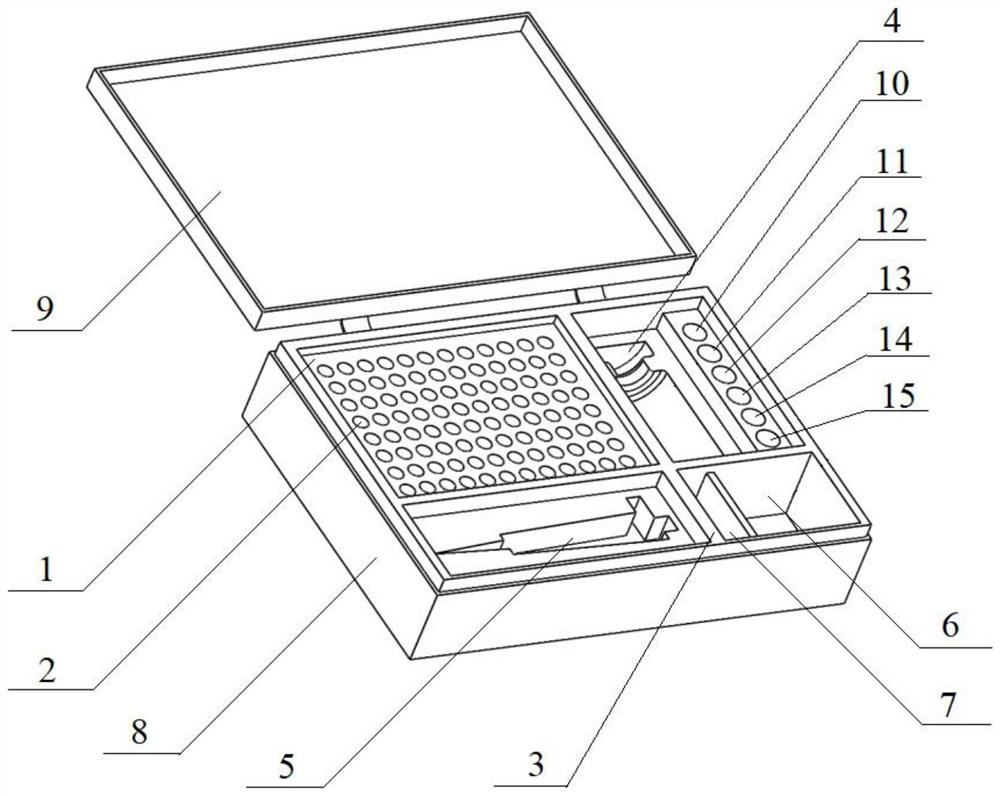Polycyclic aromatic hydrocarbon contaminated soil remediation effect evaluation method and detection kit
A polycyclic aromatic hydrocarbon and soil technology is applied in the preparation of test samples, measurement devices, and material analysis by observing the impact on chemical indicators, which can solve the problems of high cost, long time, and complicated detection methods. Achieve the effect of short time-consuming, low cost and simple operation
- Summary
- Abstract
- Description
- Claims
- Application Information
AI Technical Summary
Problems solved by technology
Method used
Image
Examples
Embodiment 1
[0040] This embodiment provides a method for detecting polycyclic aromatic hydrocarbon pollutants in soil, including,
[0041] S1. Take a soil sample, dry it, grind it, and pass it through a 20-mesh standard sieve to obtain a ground soil sample. Take 0.1 g of the ground soil sample in a 10 mL glass centrifuge tube, add 3 mL of n-hexane to it, and shake for 5 minutes for extraction. , then centrifuge at 2000rpm for 5min, transfer the supernatant to a clean graduated glass centrifuge tube with a straw, repeat the above steps three times, combine the supernatant, and heat the centrifuge tube containing the extract in water at 40°C Concentrate, then dilute to 0.1 mL with n-hexane to obtain the sample solution to be tested.
[0042] S2. Mix the formaldehyde solution with a mass fraction of 37% and the concentrated sulfuric acid with a mass fraction of 98.3% according to a volume ratio of 1:9 to obtain a mixed solution of formaldehyde and concentrated sulfuric acid; add the 0.1mL sa...
Embodiment 2
[0045] This embodiment provides a method for detecting polycyclic aromatic hydrocarbon pollutants in soil, including:
[0046] S1. Take a soil sample, air-dry it, grind it, and pass it through a 20-mesh standard sieve to obtain a ground soil sample. Take 0.1 g of the ground soil sample in a 10 mL glass centrifuge tube, add 3 mL of dichloromethane to it, and shake for 5 minutes for extraction. , then centrifuge at 2000rpm for 5min, transfer the supernatant to a clean graduated glass centrifuge tube with a straw, repeat the above steps three times, combine the supernatant, and heat the centrifuge tube containing the extract in water at 40°C Concentrate, and then dilute to 0.1 mL with dichloromethane to obtain a sample solution to be tested.
[0047] S2. Mix the formaldehyde solution with a mass fraction of 37% and the concentrated sulfuric acid with a mass fraction of 98.3% according to a volume ratio of 1:1000 to obtain a mixed solution of formaldehyde and concentrated sulfuric...
Embodiment 3
[0052] This embodiment provides a method for detecting polycyclic aromatic hydrocarbon pollutants in soil, including,
[0053] S1. Take the soil sample, air-dry it, grind it, pass through a 20-mesh standard sieve to obtain the ground soil sample, put 0.1 g of the ground soil sample in a 10 mL glass centrifuge tube, add 3 mL of dichloromethane and shake it for 5 min for extraction. Then centrifuge at 2000rpm for 5min, transfer the supernatant to a clean graduated glass centrifuge tube with a straw, repeat the above steps three times, combine the supernatant, put the centrifuge tube containing the extract in water at 40°C to heat and concentrate , and then dilute to 0.1 mL with dichloromethane to obtain the sample solution to be tested.
[0054] S2. Mix the formaldehyde solution with a mass fraction of 37% and the concentrated sulfuric acid with a mass fraction of 98.3% according to a volume ratio of 1:550 to obtain a mixed solution of formaldehyde and concentrated sulfuric acid...
PUM
 Login to View More
Login to View More Abstract
Description
Claims
Application Information
 Login to View More
Login to View More - R&D
- Intellectual Property
- Life Sciences
- Materials
- Tech Scout
- Unparalleled Data Quality
- Higher Quality Content
- 60% Fewer Hallucinations
Browse by: Latest US Patents, China's latest patents, Technical Efficacy Thesaurus, Application Domain, Technology Topic, Popular Technical Reports.
© 2025 PatSnap. All rights reserved.Legal|Privacy policy|Modern Slavery Act Transparency Statement|Sitemap|About US| Contact US: help@patsnap.com

